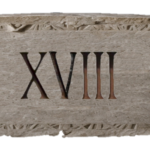1700, which is typically represented as “MDCC” in Roman numerals. Here’s the breakdown of how this representation is derived:
- M represents 1000.
- D represents 500.
- CC represents 200 (which is 100 + 100).
So, when you add these Roman numerals together, you get 1000 (M) + 500 (D) + 200 (CC), which equals 1700.
Decimal to Roman Numeral Converter
Roman Numeral:
Here are some fun historical and cultural facts about the year 1700:
- The Great Northern War: The Great Northern War, a conflict primarily between the Swedish Empire and a coalition of Russia, Poland-Lithuania, and Denmark-Norway, was ongoing in 1700. This war would continue for another two decades, ending in 1721.
- The Start of the 18th Century: 1700 marked the beginning of the 18th century in the Gregorian calendar, which is the calendar system used by most of the world today.
- The Palace of Versailles: Construction on the famous Palace of Versailles in France continued throughout the early 18th century. The palace is known for its opulent architecture and gardens and played a significant role in French history.
- The Last Year of the Julian Calendar: Many countries in Europe were still using the Julian calendar in 1700, which was 11 days behind the Gregorian calendar. This calendar discrepancy would lead to calendar reforms in various countries in the years that followed.
- Isaac Newton: The renowned English mathematician and physicist Sir Isaac Newton was alive in 1700. He made groundbreaking contributions to science, including his laws of motion and the law of universal gravitation.
- The Age of Enlightenment: The 18th century, including 1700, is often referred to as the Age of Enlightenment, a period characterized by intellectual and philosophical developments, secularism, and a focus on reason and science.
- The Spread of Coffee: Coffeehouses, which had become popular in Europe during the late 17th century, continued to be hubs for intellectual discussions and social gatherings in 1700. Coffee played a significant role in European culture during this time.
- The Year 1700 in Literature: Many notable works of literature were published around this time, including “The Way of the World” by William Congreve (1700) and “The Pilgrim’s Progress” by John Bunyan (1700).
- Cultural Differences: The world in 1700 was diverse and rich in cultural differences. Different regions had their own traditions, languages, and ways of life, contributing to the colorful tapestry of human history.
- Exploration and Colonization: European powers continued their exploration and colonization efforts during this period, expanding their empires and encountering new cultures and territories around the world.

